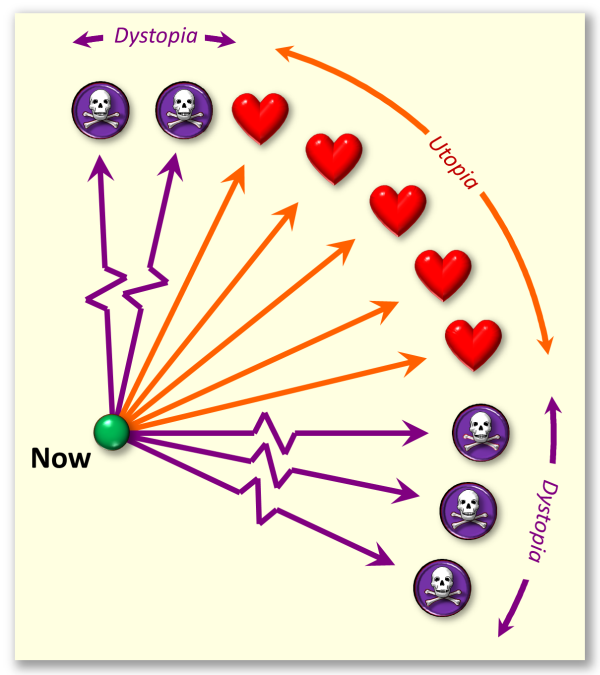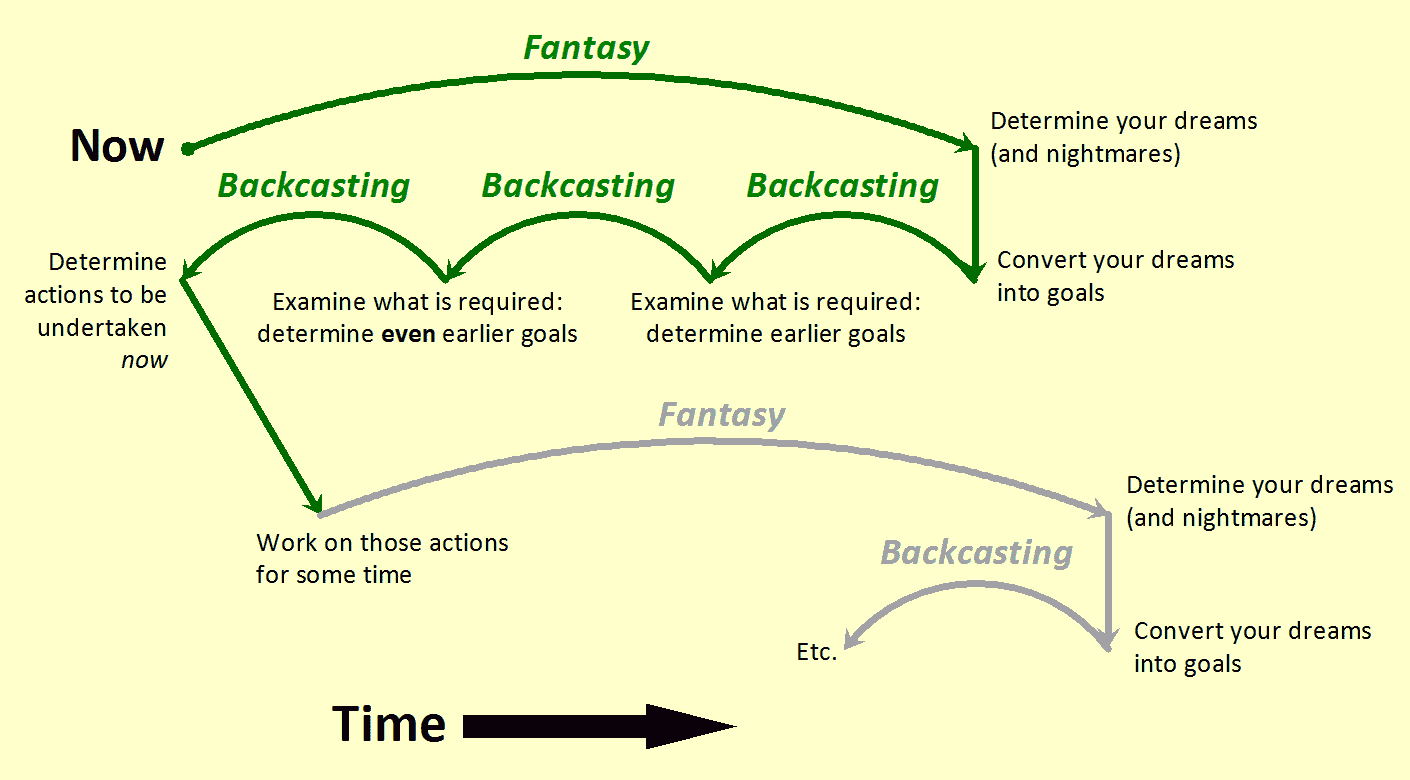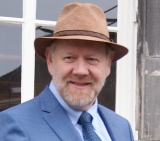FFEA Extensions: example # 2 Backcasting the Future |
> This extension is applied in assignments for the academic textbooks on sustainability & CSR.
A Forum Methode for the purpose of increasing the innovate power of an organization and its relation with the future
On this page:
Step 1: Determining the perspectives on the future
Step 2: Determining actions
Step 3: Undertaking actions and returning to the start
A group - the 'Forum' - is composed to discuss in a creative way the future of the organization. Not through forecasting (which is totally impossible) but through backcasting (which is quite the opposite).
(By the way: 'Weather forecasting' is not really about forecasting, but about calculated probabilities - which is not the same.)
The Forum is composed of people that matter to the organization. Such as: board members and managers, employees and customers, external experts within the professional field, maybe even famous futurologists.
The Forum meets once or perhaps several times, chaired by an experienced discussion leader. Through a process of brainstorming they create imeges of possible futures. Next, they derive conculsions for the strategy and the short-term policy of the organization.
The first step in designing a roadmap to the future for your organization consists of considering the world you would like to have. That means considering and nurturing dreams, just as Martin Luther King did (‘I have a dream!’). At the same time you are required to do the opposite, and think of nightmares, which means coming up with images or fantasies concerning future developments that are alarming or scary. |
This may concern unpleasant developments in the outside world. One of those nightmares might involve a world in which the environment is so badly devastated that the entire human population is suffering from famine. A dream, meanwhile, could involve a world where wars are no longer fought because nobody has a reason to fight.
The Forum that discusses such possible future development will no doubt also discuss dreams and nightmares related to the future of the own organization: varying from perhaps true nightmares such as bankrupcy or even criminal charges, to brilliant futures involving perhaps huge profits, organizational growth or considerable contributions to society and sustainable development.
A pleasant fantasy world is called a utopia, with the name derived from an eponymous book written in 1516 by Thomas More, in which he dreamed of an ideal world. The opposite of a utopia is a dystopia, which is a world in which everything goes wrong, a scenario of doom. In considering these futures, one can be as creative and playful as possible.
Step 1: Determining the perspectives on the future
 The first step is to design perspectives on the future. One must not keep to a single possible future, as it will certainly not work out exactly anyway. It is best if an entire series of these possible futures is created, both utopias and dystopias. The participants in the process make full use of their fantasies, their dreams and their nightmares. They use their knowledge and understanding of the weaknesses and strengths of the present, as well as tools such as models and future scenarios. They also take robust trends into account, creating a picture of the futures (mostly dystopias) that can probably be expected if current policies remain unchanged.
The first step is to design perspectives on the future. One must not keep to a single possible future, as it will certainly not work out exactly anyway. It is best if an entire series of these possible futures is created, both utopias and dystopias. The participants in the process make full use of their fantasies, their dreams and their nightmares. They use their knowledge and understanding of the weaknesses and strengths of the present, as well as tools such as models and future scenarios. They also take robust trends into account, creating a picture of the futures (mostly dystopias) that can probably be expected if current policies remain unchanged.
The most interesting creative process comes into being when people with different values systems join in the process, so that we can see whether they are able to find common dreams. Visionary people – people with a strong power of imagination – are required to avoid the entire exercise becoming stuck in the world of today. It is a good idea to select an interdisciplinary team, and the participants do not all have to be experts. ‘Ordinary’ people can also participate in order to have a broad social basis, which creates a transdisciplinary approach. One way to do this could consist of a good spread across younger and older people. The result of the process will be a range of possible futures (see the figure on the right).
A number of desirable futures (utopias) are worked out in concrete terms, taking on the form of goals to be achieved. A distant point is chosen for this. Depending in the context, this may be 10, 20 or even 50 years from the present.
Next the participants examine what must be done before that period has expired in order to make the goals feasible. For example, they step back 5 or 10 years from the end time and come up with interim goals that must be achieved by that stage to make the final goals feasible. It is this step that involves the actual ‘backcasting’.
If necessary, this step is repeated several times, and each time a further step is taken back in time, towards the present. In the end, there is a step-by-step strategy that - theoretically - will make it possible to make the dream for the future come true within the allotted period. The final step of this stage results in short-term goals, which are feasible through actions that can be commenced now.

Once this process is performed for a number of desirable futures, we are presented with an overview of the actions that must be undertaken at present so that we can move in the direction of these desirable futures. That does not mean that these actions will guarantee one of these futures – the future is, and remains, unpre-dictable. What they are, however, are actions that unlock the future – if we do not undertake them now, that desirable future will be unattainable or, in any event, its attainability will be delayed.
Step 3: Undertaking actions and returning to the start
Once the appropriate actions have been determined in the manner outlined above, the participants in the process set about making choices. In the following years the selected actions are undertaken, while in the meantime the world continues evolving, partly as a result of the undertaken actions and partly as a result of other – sometimes unexpected – events. This causes all the future perspectives and scenarios to change, and not just their content bus also the degree of their likelihood. That is the reason why backcasting does not pro-vide a definitive long-term path, but instead only granting directions for a limited number of years. At the con-clusion of that period the entire process is repeated, starting from step 1. The result is fresh indications for actions, which we again work on for a number of years, and so on.
The three steps are continuously repeated, leading to sustainable developments. Figure 5 provides a diagram-matic overview of the entire process.
In this manner sustainable development is used as an indicator – as a precondition when it comes to selecting certain actions and discarding others. It allows us to make decisions that are supported by many, because a broad group has participated in the process. Another benefit is that it is inspiring – it elicits the best from peo-ple, from their fantasies, their ideals and their enthusiasm.
You could backcast over extended periods or short ones, and it can be done at once for all the problems the world is confronted with – although that will become an extraordinarily complex process – or just for individual issues.
The process of Backcasting was originally designed as a tool for sustainable development around the year 1990. It was applied in the STD program ('Sustainable Technological Development'), chaired by Prof. dr. Leo Jansen. Sources for further study are:
- Vergragt PJ, Jansen L (1993): Sustainable technological development: the making of a long-term oriented technology programme, Project Appraisal 8: 134-140
- Weaver P, Jansen L, Van Grootveld G, van Spiegel E, Vergragt P (2000) Sustainable technology development, Greenleaf Publishers, Sheffield UK.
- Quist, Jacobus Nicolaas (2007): Backcasting for a sustainable future, the impact after 10 years. PhD dissertation, Delft University of Technology.

